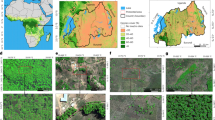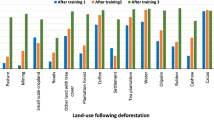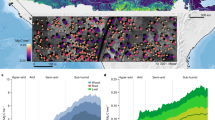Abstract
A large proportion of dryland trees and shrubs (hereafter referred to collectively as trees) grow in isolation, without canopy closure. These non-forest trees have a crucial role in biodiversity, and provide ecosystem services such as carbon storage, food resources and shelter for humans and animals1,2. However, most public interest relating to trees is devoted to forests, and trees outside of forests are not well-documented3. Here we map the crown size of each tree more than 3 m2 in size over a land area that spans 1.3 million km2 in the West African Sahara, Sahel and sub-humid zone, using submetre-resolution satellite imagery and deep learning4. We detected over 1.8 billion individual trees (13.4 trees per hectare), with a median crown size of 12 m2, along a rainfall gradient from 0 to 1,000 mm per year. The canopy cover increases from 0.1% (0.7 trees per hectare) in hyper-arid areas, through 1.6% (9.9 trees per hectare) in arid and 5.6% (30.1 trees per hectare) in semi-arid zones, to 13.3% (47 trees per hectare) in sub-humid areas. Although the overall canopy cover is low, the relatively high density of isolated trees challenges prevailing narratives about dryland desertification5,6,7, and even the desert shows a surprisingly high tree density. Our assessment suggests a way to monitor trees outside of forests globally, and to explore their role in mitigating degradation, climate change and poverty.
This is a preview of subscription content, access via your institution
Access options
Access Nature and 54 other Nature Portfolio journals
Get Nature+, our best-value online-access subscription
$29.99 / 30 days
cancel any time
Subscribe to this journal
Receive 51 print issues and online access
$199.00 per year
only $3.90 per issue
Buy this article
- Purchase on Springer Link
- Instant access to full article PDF
Prices may be subject to local taxes which are calculated during checkout




Similar content being viewed by others
Data availability
Global tree cover maps are available at http://earthenginepartners.appspot.com/science-2013-global-forest. CHIRPS rainfall data are freely available at the Climate Hazard Group (https://www.chc.ucsb.edu/data/chirps). The Copernicus land-use map can be downloaded at https://land.copernicus.eu/global/. Commercial very-high-resolution satellite images were acquired by NASA, under a NextView Imagery End User Licence Agreement. The copyright remains with DigitalGlobe, and redistribution is not possible. However, the derived products produced in this Article are made publicly available at the Oak Ridge National Laboratory at https://doi.org/10.3334/ORNLDAAC/1832. Any further relevant data are available from the corresponding authors upon reasonable request.
Code availability
The tree detection framework based on U-Net is publicly available at https://doi.org/10.5281/zenodo.3978185; support and more information are available from A.K. (kariryaa@uni-bremen.de or ankit.ky@gmail.com).
References
Bayala, J., Sanou, J., Teklehaimanot, Z., Kalinganire, A. & Ouédraogo, S. Parklands for buffering climate risk and sustaining agricultural production in the Sahel of West Africa. Curr. Opin. Environ. Sustain. 6, 28–34 (2014).
Stringer, L. C. et al. Challenges and opportunities in linking carbon sequestration, livelihoods and ecosystem service provision in drylands. Environ. Sci. Policy 19–20, 121–135 (2012).
Schnell, S., Kleinn, C. & Ståhl, G. Monitoring trees outside forests: a review. Environ. Monit. Assess. 187, 600 (2015).
LeCun, Y., Bengio, Y. & Hinton, G. Deep learning. Nature 521, 436–444 (2015).
Darkoh, M. B. K. The nature, causes and consequences of desertification in the drylands of Africa. Land Degrad. Dev. 9, 1–20 (1998).
Ribot, J. C. A history of fear: imagining deforestation in the West African dryland forests. Glob. Ecol. Biogeogr. 8, 291–300 (1999).
Fairhead, J. & Leach, M. False forest history, complicit social analysis: rethinking some West African environmental narratives. World Dev. 23, 1023–1035 (1995).
Hansen, M. C. et al. High-resolution global maps of 21st-century forest cover change. Science 342, 850–853 (2013).
Ickowitz, A., Powell, B., Salim, M. A. & Sunderland, T. C. H. Dietary quality and tree cover in Africa. Glob. Environ. Change 24, 287–294 (2014).
Baudron, F., Chavarría, J. Y. D., Remans, R., Yang, K. & Sunderland, T. Indirect contributions of forests to dietary diversity in Southern Ethiopia. Ecol. Soc. 22, 28 (2017).
Angelsen, A. et al. Environmental income and rural livelihoods: a global-comparative analysis. World Dev. 64, S12–S28 (2014).
Reed, J. et al. Trees for life: the ecosystem service contribution of trees to food production and livelihoods in the tropics. For. Policy Econ. 84, 62–71 (2017).
Brito, J. C. et al. Unravelling biodiversity, evolution and threats to conservation in the Sahara-Sahel. Biol. Rev. Camb. Philos. Soc. 89, 215–231 (2014).
Brandt, M. et al. Satellite passive microwaves reveal recent climate-induced carbon losses in African drylands. Nat. Ecol. Evol. 2, 827–835 (2018).
de Foresta, H. et al. Towards the Assessment of Trees Outside Forests (Resources Assessment Working Paper 183) (FAO, 2013).
Crowther, T. W. et al. Mapping tree density at a global scale. Nature 525, 201–205 (2015).
Axelsson, C. R. & Hanan, N. P. Patterns in woody vegetation structure across African savannas. Biogeosciences 14, 3239–3252 (2017).
Schepaschenko, D. et al. Comment on “The extent of forest in dryland biomes”. Science 358, eaao0166 (2017).
Bastin, J.-F. et al. The extent of forest in dryland biomes. Science 356, 635–638 (2017).
Song, X.-P. et al. Global land change from 1982 to 2016. Nature 560, 639–643 (2018).
Brandt, M. et al. Reduction of tree cover in West African woodlands and promotion in semi-arid farmlands. Nat. Geosci. 11, 328–333 (2018).
Brandt, M. et al. Woody plant cover estimation in drylands from Earth observation based seasonal metrics. Remote Sens. Environ. 172, 28–38 (2016).
Reichstein, M. et al. Deep learning and process understanding for data-driven Earth system science. Nature 566, 195–204 (2019).
Ronneberger, O., Fischer P. & Brox, T. U-net: convolutional networks for biomedical image segmentation. In International Conference on Medical Image Computing and Computer-Assisted Intervention (eds. Navab, N. et al.) 234–241, (Springer, 2015).
Muller-Landau, H. C. et al. Comparing tropical forest tree size distributions with the predictions of metabolic ecology and equilibrium models. Ecol. Lett. 9, 589–602 (2006).
Buchhorn, M. et al. Copernicus global land service: land cover 100 m: epoch 2018: Africa demo. https://land.copernicus.eu/global/products/lc (2019).
Wood, S. A. & Baudron, F. Soil organic matter underlies crop nutritional quality and productivity in smallholder agriculture. Agric. Ecosyst. Environ. 266, 100–108 (2018).
Sandbrook, C., Sunderland, T., & Tu, T. N. in Forests and Food (eds Bhaskar, V. et al.) 73–136 (Open Book, 2015).
Rasolofoson, R. A., Hanauer, M. M., Pappinen, A., Fisher, B. & Ricketts, T. H. Impacts of forests on children’s diet in rural areas across 27 developing countries. Sci. Adv. 4, eaat2853 (2018).
Griscom, B. W. et al. Natural climate solutions. Proc. Natl Acad. Sci. USA 114, 11645–11650 (2017).
Tucker, C. J. Red and photographic infrared linear combinations for monitoring vegetation. Remote Sens. Environ. 8, 127–150 (1979).
LeCun, Y. et al. Handwritten digit recognition with a back-propagation network. In Advances in Neural Information Processing Systems 2 (ed. Touretzky, D. S.) 396–404 (Neural Information Processing Systems Foundation, 1990).
Long, J., Shelhamer, E. & Darrell, T. Fully convolutional networks for semantic segmentation. In Proc. IEEE Conference on Computer Vision and Pattern Recognition (CVPR) (eds Bischof, H. et al.) 3431–3440 (IEEE Computer Society, 2015).
Sermanet, P. et al. OverFeat: integrated recognition, localization and detection using convolutional networks. Preprint at https://arxiv.org/abs/1312.6229 (2014).
Cordts, M. et al. The cityscapes dataset for semantic urban scene understanding. In Proc. IEEE Conference on Computer Vision and Pattern Recognition (CVPR) (eds Bajcsy, R. et al.) 3213–3223 (IEEE Computer Society, 2016).
Simpson, A. L. et al. A large annotated medical image dataset for the development and evaluation of segmentation algorithms. Preprint at https://arxiv.org/abs/1902.09063 (2019).
Perslev, M., Dam, E., Pai, A. & Igel, C. One network to segment them all: a general, lightweight system for accurate 3D medical image segmentation. In Medical Image Computing and Computer Assisted Intervention (MICCAI) (eds Shen, D. et al.) 30–38 (Springer, 2019).
Koch, T., Perslev, M., Igel, C. & Brandt, S. Accurate segmentation of dental panoramic radiographs with U-nets. In Proc. IEEE International Symposium on Biomedical Imaging (ISBI) (eds Davis, L. et al.) 15–19 (IEEE Computer Society, 2019).
Srivastava, N. et al. Dropout: a simple way to prevent neural networks from overfitting. J. Mach. Learn. Res. 15, 1929–1958 (2014).
Ioffe, S. & Szegedy, C. Batch normalization: accelerating deep network training by reducing internal covariate shift. In International Conference on Machine Learning (ICML) (eds Bach, F. & Blei, D.) 448–456 (PMLR, 2015).
Odena, A., Dumoulin, V. & Olah, C. Deconvolution and checkerboard artifacts. Distill https://distill.pub/2016/deconv-checkerboard/ (2016).
Sadegh, S., Salehi, M., Erdogmus, D. & Gholipour, A. Tversky loss function for image segmentation using 3D fully convolutional deep networks. In International Workshop on Machine Learning in Medical Imaging (eds Wang, Q. et al.) 379–387 (Springer, 2017).
Funk, C. et al. The climate hazards infrared precipitation with stations—a new environmental record for monitoring extremes. Sci. Data 2, 150066 (2015).
Hengl, T. et al. Mapping soil properties of Africa at 250 m resolution: random forests significantly improve current predictions. PLoS ONE 10, e0125814 (2015).
Acknowledgements
We thank Maxar for providing commercial satellite data through the NextView Imagery End User Licence Agreement of the National Geospatial Intelligence Agency. This research is part of the Blue Waters sustained peta-scale computing project, which is supported by the National Science Foundation (awards OCI-0725070 and ACI-1238993), the State of Illinois and—as of December 2019—the National Geospatial-Intelligence Agency. Blue Waters is a joint effort of the University of Illinois at Urbana-Champaign and its National Center for Supercomputing Applications. M.B. was financed by an AXA post-doctoral research grant and a DFF Sapere Aude grant (9064-00049B). A.K. and J. Schöning were funded by a Lichtenberg Professorship of the Volkswagen Foundation. J.C. acknowledges ANR grants (CEBA, ref. ANR-10-LABX-25-01 and TULIP: ANR-10-LABX-0041). We acknowledge support by the Villum Foundation through the project ‘Deep Learning and Remote Sensing for Unlocking Global Ecosystem Resource Dynamics’ (DeReEco). L.V.R. was funded by the European Research Council (ERC) under the European Union’s Horizon 2020 research and innovation programme (grant agreement no. 853222 FORESTDIET). This Article contributes to the Global Land Programme, glp.earth. We thank the group around M. Hansen for making their product on global tree cover freely available; T. Lee for suggesting this project; K. Murphy for his support; D. Duffy for his high-performance computing support; S. Keesey, C. Williamson, C. Crittenden, K. Allen, M. Schlenk, B. Bates and K. Peterman for their satellite data contributions; and W. Kramer and B. Bode for their high-performance computing support. Approved for public release, no. 20-732.
Author information
Authors and Affiliations
Contributions
M.B., C.J.T., R.F. and K.R. designed the study. C.J.T., J. Small, S.S., J.M., E.R., E.G. and K.M. prepared and processed the satellite data. M.B. selected the training data. A.K. wrote the code for the deep-learning framework, supported by S.L., J. Schöning, F.G., J.M. and C.I. M.B., C.A., A.K. and J.C. conducted the analyses. Interpretations were done by P.H., J.C., R.F., K.R., L.K., O.M., A.M. and A.A.D. M.D, C.A. and R.F. collected the field data. K.R., M.B. and L.V.R. wrote the first manuscript draft with contributions by all authors. M.B. designed the figures.
Corresponding authors
Ethics declarations
Competing interests
The authors declare no competing interests.
Additional information
Peer review information Nature thanks Niall Hanan, Liming Zhou and the other, anonymous, reviewer(s) for their contribution to the peer review of this work.
Publisher’s note Springer Nature remains neutral with regard to jurisdictional claims in published maps and institutional affiliations.
Extended data figures and tables
Extended Data Fig. 1 Predicting tree crowns.
This set of 256 × 256-pixel plots from the independent test dataset shows the capabilities of the convolutional neural network model to predict trees (right column) from panchromatic images (left column) and NDVI (central column) at 0.5-m resolution.
Extended Data Fig. 2 Evaluation.
a, Manually labelled tree crowns from the independent test dataset are compared against predictions. The comparison is done for 100 random plots each having 256 × 256 pixels. Here, the canopy area (in m2) of the trees in the plots is compared. b, As in a, but for the density (the number of labelled or predicted trees per plot). c, As in a, but for mean crown size per plot. d, The crown sizes of 102 in situ measured trees from 2 field campaigns in Senegal (Extended Data Fig. 4) are compared with the predicted ones. Extended Data Table 2 provides more details. n = 100 plots with 256 × 256-pixel size.
Extended Data Fig. 3 Mapping individual tree crowns.
a, Before training the model, the spaces between labelled tree crowns (light blue) were filled (red) and given a higher weight. During training, the model was penalized more strongly for wrongly classifying gap pixels compared to other misclassifications. As a result, tree crowns that touch or are close to each other could be reliably separated. b, Examples of predicted trees (green), showing that most trees standing close to each other were mapped as individuals trees.
Extended Data Fig. 4 Overview of training sites and study area.
The study area for the wall-to-wall mapping is the westernmost part of the Sahara and Sahel. It represents a typical north–south ecological and climatic gradient, starting in the Sahara Desert in hyper-arid areas (rainfall of 0–150 mm yr−1) with a sparse vegetation coverage, over arid (rainfall of 150–300 mm yr−1) and semi-arid (rainfall of 300–600 mm yr−1) Sahelian rangelands and croplands, up to sub-humid (rainfall of 600–1,000 mm yr−1) Sudanian lands, where shrublands turn into forests. a, The locations of the manually drawn 89,899 tree crowns used for training the model are shown in red. CHIRPS rainfall43 was used to delineate the rainfall zones. The land use for farmland and urban is from Copernicus Global Land26. In situ data were collected at the field sites around Widou and Dahra in Senegal. Areas of insufficient data quality and beyond rainfall of 1,000 mm yr−1 were masked. b, The region was analysed for sandy (>70% sand content) and non-sandy areas44.
Extended Data Fig. 5 Variables mapped in this study.
a, The density of trees with a crown size larger 3 m2 per hectare. b, The canopy cover. c, Mean crown size. All variables were mapped by 100 × 100-m (1-ha) grids. Rainfall isohyets of 150, 300, 600 and 1,000 mm yr−1 are also shown.
Extended Data Fig. 6 Tree density classes.
a–d, The tree density per hectare is shown for different crown size classes: 3–15 m2 (a), 15–50 m2 (b), 50–200 m2 (c), and >200 m2 (d). Trees in the class >200 m2 typically do not represent individual tree crowns, but instead reflect closed-canopy areas. Trees <3 m2 are not shown, owing high uncertainty in this class.
Extended Data Fig. 7 Comparisons with other datasets.
a, Canopy cover of the study area from ref. 8. b, Field-measured crown diameter (derived from crown size 3–200 m2) of 811 individual trees measured in situ in the Ferlo of Senegal21. The y-axis has been log-transformed. c, As in b, but for the crown size and without log transformation. d, Woody cover derived from individual trees differs from the current state-of-the-art tree cover map from ref. 19. n = 4,017 grids; r2 = 0.28.
Extended Data Fig. 8 Overview of satellite images.
We used 11,128 multispectral images from the QuickBird-2, GeoEye-1, WorldView-2 and WorldView-3 satellites, acquired from November to March of 2005–2018. Priority was set to images from the early dry season (starting in November), and an off-nadir angle of <25°. Although the model has been trained and validated to work for late-dry season images, the uncertainty is higher in February and March. a, Image acquisition months. b, Sun azimuth at the image acquisition time. c, Off-nadir angle shown for each image.
Supplementary information
Supplementary Information
This file contains Supplementary Figures 1-4 and Supplementary Table 1.
Rights and permissions
About this article
Cite this article
Brandt, M., Tucker, C.J., Kariryaa, A. et al. An unexpectedly large count of trees in the West African Sahara and Sahel. Nature 587, 78–82 (2020). https://doi.org/10.1038/s41586-020-2824-5
Received:
Accepted:
Published:
Issue Date:
DOI: https://doi.org/10.1038/s41586-020-2824-5
This article is cited by
-
Trees on smallholder farms and forest restoration are critical for Rwanda to achieve net zero emissions
Communications Earth & Environment (2024)
-
Fine-grained urban blue-green-gray landscape dataset for 36 Chinese cities based on deep learning network
Scientific Data (2024)
-
Scattered tree death contributes to substantial forest loss in California
Nature Communications (2024)
-
Assessment of Tree Density, Tree Cover, Species Diversity and Biomass in Semi-arid Human Dominated Landscape Using Large Area Inventory and Remote Sensing Data
Anthropocene Science (2024)
-
A joint framework for studying compound ecoclimatic events
Nature Reviews Earth & Environment (2023)
Comments
By submitting a comment you agree to abide by our Terms and Community Guidelines. If you find something abusive or that does not comply with our terms or guidelines please flag it as inappropriate.



